tow HYUNDAI TUCSON 2005 Owners Manual
[x] Cancel search | Manufacturer: HYUNDAI, Model Year: 2005, Model line: TUCSON, Model: HYUNDAI TUCSON 2005Pages: 273, PDF Size: 11.53 MB
Page 14 of 273
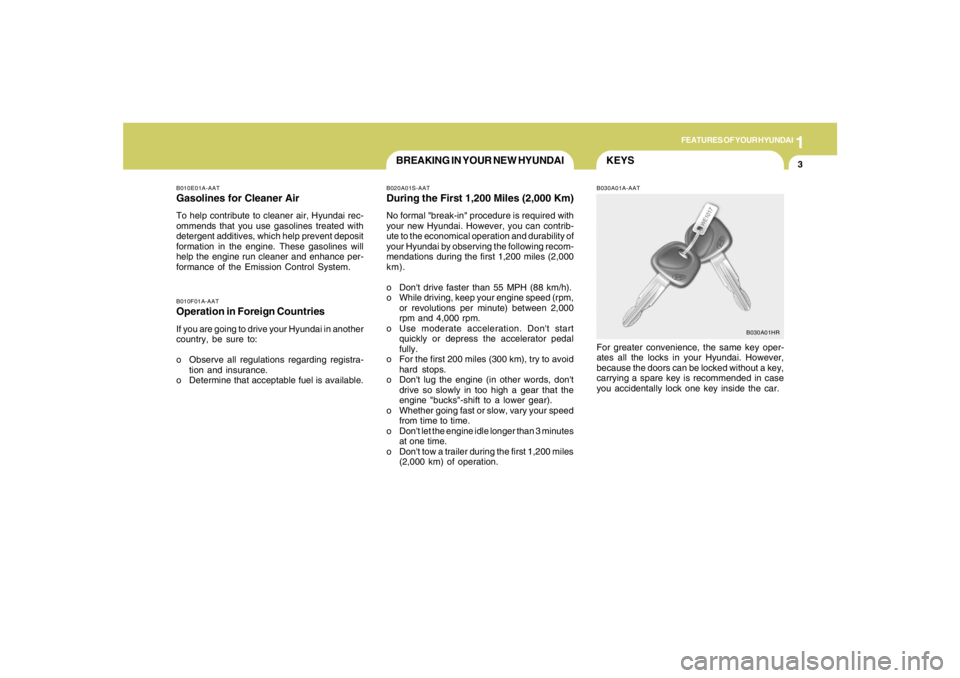
1
FEATURES OF YOUR HYUNDAI
3
KEYS
BREAKING IN YOUR NEW HYUNDAI
B010F01A-AATOperation in Foreign CountriesIf you are going to drive your Hyundai in another
country, be sure to:
o Observe all regulations regarding registra-
tion and insurance.
o Determine that acceptable fuel is available.B010E01A-AATGasolines for Cleaner AirTo help contribute to cleaner air, Hyundai rec-
ommends that you use gasolines treated with
detergent additives, which help prevent deposit
formation in the engine. These gasolines will
help the engine run cleaner and enhance per-
formance of the Emission Control System.
B020A01S-AATDuring the First 1,200 Miles (2,000 Km)No formal "break-in" procedure is required with
your new Hyundai. However, you can contrib-
ute to the economical operation and durability of
your Hyundai by observing the following recom-
mendations during the first 1,200 miles (2,000
km).
o Don't drive faster than 55 MPH (88 km/h).
o While driving, keep your engine speed (rpm,
or revolutions per minute) between 2,000
rpm and 4,000 rpm.
o Use moderate acceleration. Don't start
quickly or depress the accelerator pedal
fully.
o For the first 200 miles (300 km), try to avoid
hard stops.
o Don't lug the engine (in other words, don't
drive so slowly in too high a gear that the
engine "bucks"-shift to a lower gear).
o Whether going fast or slow, vary your speed
from time to time.
o Don't let the engine idle longer than 3 minutes
at one time.
o Don't tow a trailer during the first 1,200 miles
(2,000 km) of operation.
B030A01A-AATFor greater convenience, the same key oper-
ates all the locks in your Hyundai. However,
because the doors can be locked without a key,
carrying a spare key is recommended in case
you accidentally lock one key inside the car.
B030A01HR
Page 16 of 273
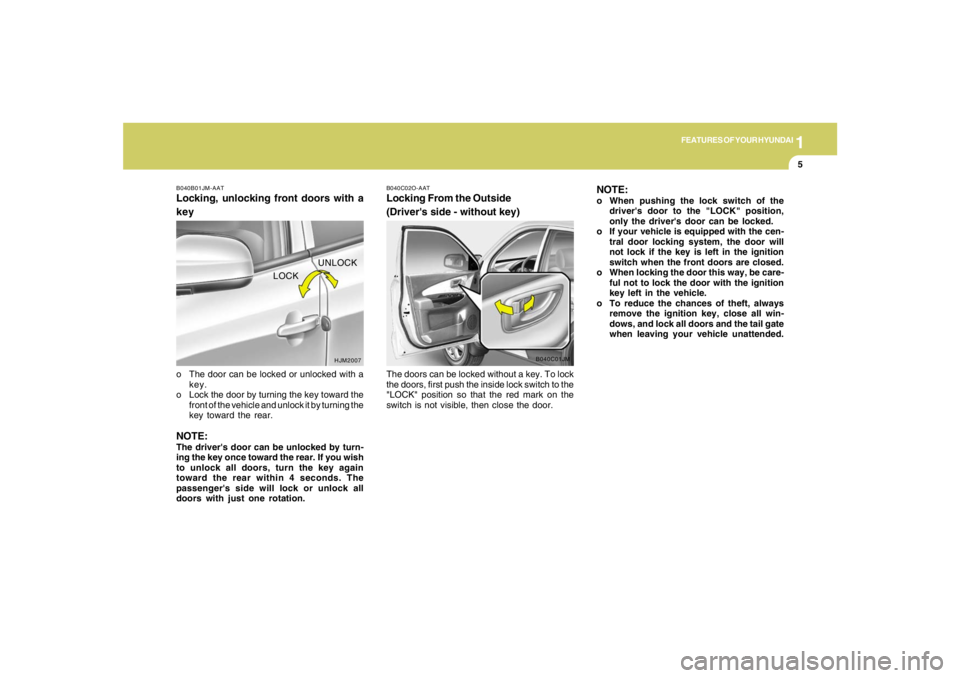
1
FEATURES OF YOUR HYUNDAI
5
UNLOCK
LOCK
HJM2007 B040B01JM-AAT
Locking, unlocking front doors with a
keyo The door can be locked or unlocked with a
key.
o Lock the door by turning the key toward the
front of the vehicle and unlock it by turning the
key toward the rear.NOTE:The driver's door can be unlocked by turn-
ing the key once toward the rear. If you wish
to unlock all doors, turn the key again
toward the rear within 4 seconds. The
passenger's side will lock or unlock all
doors with just one rotation.
B040C01JM B040C02O-AAT
Locking From the Outside
(Driver's side - without key)The doors can be locked without a key. To lock
the doors, first push the inside lock switch to the
"LOCK" position so that the red mark on the
switch is not visible, then close the door.
NOTE:o When pushing the lock switch of the
driver's door to the "LOCK" position,
only the driver's door can be locked.
o If your vehicle is equipped with the cen-
tral door locking system, the door will
not lock if the key is left in the ignition
switch when the front doors are closed.
o When locking the door this way, be care-
ful not to lock the door with the ignition
key left in the vehicle.
o To reduce the chances of theft, always
remove the ignition key, close all win-
dows, and lock all doors and the tail gate
when leaving your vehicle unattended.
Page 18 of 273

1
FEATURES OF YOUR HYUNDAI
7
B045D01JM-AATLocking From the Inside
(Passenger's side)To lock the door from the inside, simply close the
door and push the lock switch to the "LOCK"
position. When this is done, neither the outside
nor the passenger's inside door handles can be
used.NOTE:o When pushing the lock switch of the
passenger's door to the "LOCK" posi-
tion, only the passenger's door locks.
o When the door is locked, the red mark on
the switch is not visible.
HJM2008-D
UNLOCK
LOCK
B040E04A-AATChild-Protector Rear Door LockYour Hyundai is equipped with left and right side
"child-protector" rear door locks. When the lock
mechanism is engaged, the rear door cannot be
opened from the inside. Its use is recommended
whenever there are small children in the rear
seat.
To engage the child-protector feature so that
the door cannot be opened from the inside,
move the child-protector lever to the " "
position and close the door. Move the lever to
the opposite direction of " " position when
normal door operation is desired.
To open the door from the outside, pull the
outside door handle.
HJM2011
B040G02HP-AATCentral Door LocksThe central door locking switch is located on
the driver's arm rest. It is operated by depress-
ing the door lock switch.NOTE:o When pushing the front portion of the
driver's door lock switch, all vehicle
doors will lock. If any door is open when
the switch is depressed, the door will
remain locked when closed.
o When pushing the rear portion of the
switch, all vehicle doors will unlock.
o The central door locking is operated by
turning the key in the driver's door lock
toward the front or rear of the vehicle.
HJM2009
Page 23 of 273
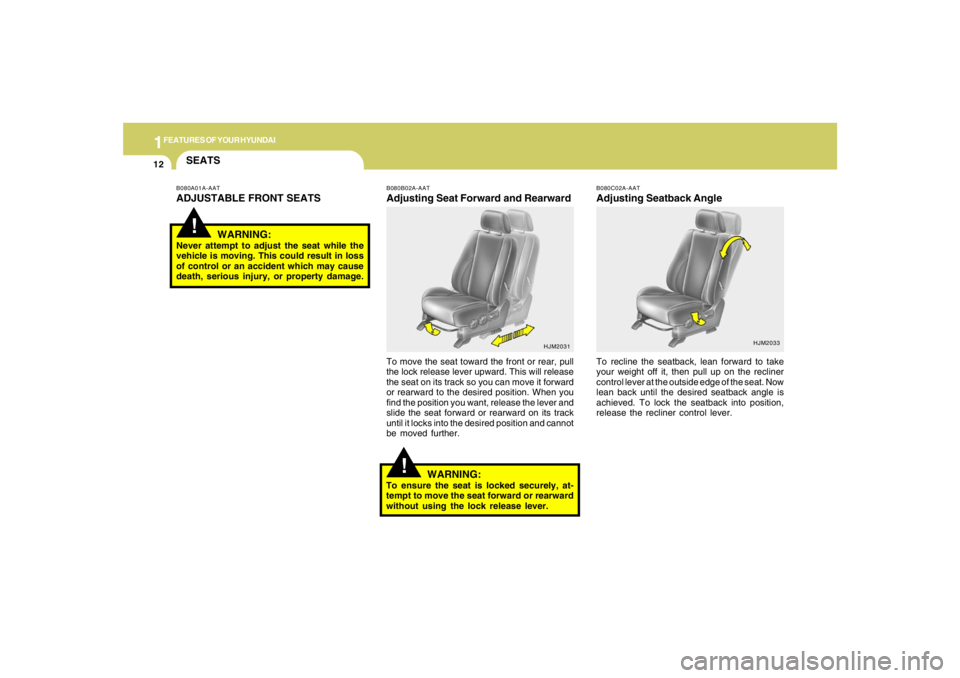
1FEATURES OF YOUR HYUNDAI12
HJM2033
!
B080B02A-AATAdjusting Seat Forward and RearwardTo move the seat toward the front or rear, pull
the lock release lever upward. This will release
the seat on its track so you can move it forward
or rearward to the desired position. When you
find the position you want, release the lever and
slide the seat forward or rearward on its track
until it locks into the desired position and cannot
be moved further.
B080C02A-AATAdjusting Seatback AngleTo recline the seatback, lean forward to take
your weight off it, then pull up on the recliner
control lever at the outside edge of the seat. Now
lean back until the desired seatback angle is
achieved. To lock the seatback into position,
release the recliner control lever.
WARNING:
To ensure the seat is locked securely, at-
tempt to move the seat forward or rearward
without using the lock release lever.
HJM2031
SEATSB080A01A-AATADJUSTABLE FRONT SEATS
!
WARNING:
Never attempt to adjust the seat while the
vehicle is moving. This could result in loss
of control or an accident which may cause
death, serious injury, or property damage.
Page 35 of 273
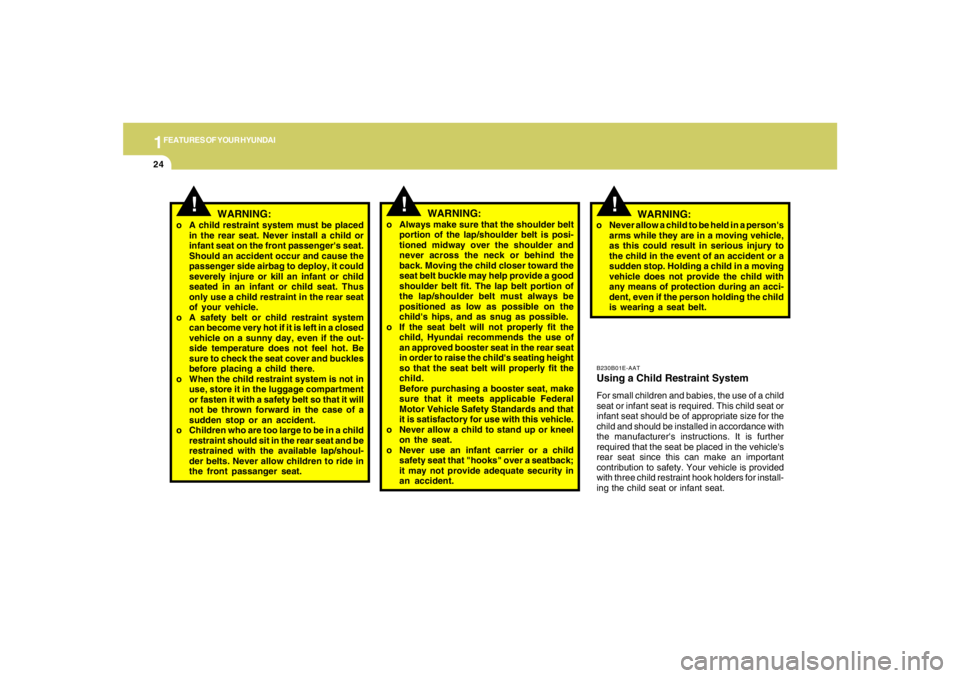
1FEATURES OF YOUR HYUNDAI24
B230B01E-AATUsing a Child Restraint SystemFor small children and babies, the use of a child
seat or infant seat is required. This child seat or
infant seat should be of appropriate size for the
child and should be installed in accordance with
the manufacturer's instructions. It is further
required that the seat be placed in the vehicle's
rear seat since this can make an important
contribution to safety. Your vehicle is provided
with three child restraint hook holders for install-
ing the child seat or infant seat.
!
WARNING:
o Always make sure that the shoulder belt
portion of the lap/shoulder belt is posi-
tioned midway over the shoulder and
never across the neck or behind the
back. Moving the child closer toward the
seat belt buckle may help provide a good
shoulder belt fit. The lap belt portion of
the lap/shoulder belt must always be
positioned as low as possible on the
child's hips, and as snug as possible.
o If the seat belt will not properly fit the
child, Hyundai recommends the use of
an approved booster seat in the rear seat
in order to raise the child's seating height
so that the seat belt will properly fit the
child.
Before purchasing a booster seat, make
sure that it meets applicable Federal
Motor Vehicle Safety Standards and that
it is satisfactory for use with this vehicle.
o Never allow a child to stand up or kneel
on the seat.
o Never use an infant carrier or a child
safety seat that "hooks" over a seatback;
it may not provide adequate security in
an accident.
WARNING:
o Never allow a child to be held in a person's
arms while they are in a moving vehicle,
as this could result in serious injury to
the child in the event of an accident or a
sudden stop. Holding a child in a moving
vehicle does not provide the child with
any means of protection during an acci-
dent, even if the person holding the child
is wearing a seat belt.
!
!
WARNING:
o A child restraint system must be placed
in the rear seat. Never install a child or
infant seat on the front passenger's seat.
Should an accident occur and cause the
passenger side airbag to deploy, it could
severely injure or kill an infant or child
seated in an infant or child seat. Thus
only use a child restraint in the rear seat
of your vehicle.
o A safety belt or child restraint system
can become very hot if it is left in a closed
vehicle on a sunny day, even if the out-
side temperature does not feel hot. Be
sure to check the seat cover and buckles
before placing a child there.
o When the child restraint system is not in
use, store it in the luggage compartment
or fasten it with a safety belt so that it will
not be thrown forward in the case of a
sudden stop or an accident.
o Children who are too large to be in a child
restraint should sit in the rear seat and be
restrained with the available lap/shoul-
der belts. Never allow children to ride in
the front passanger seat.
Page 39 of 273
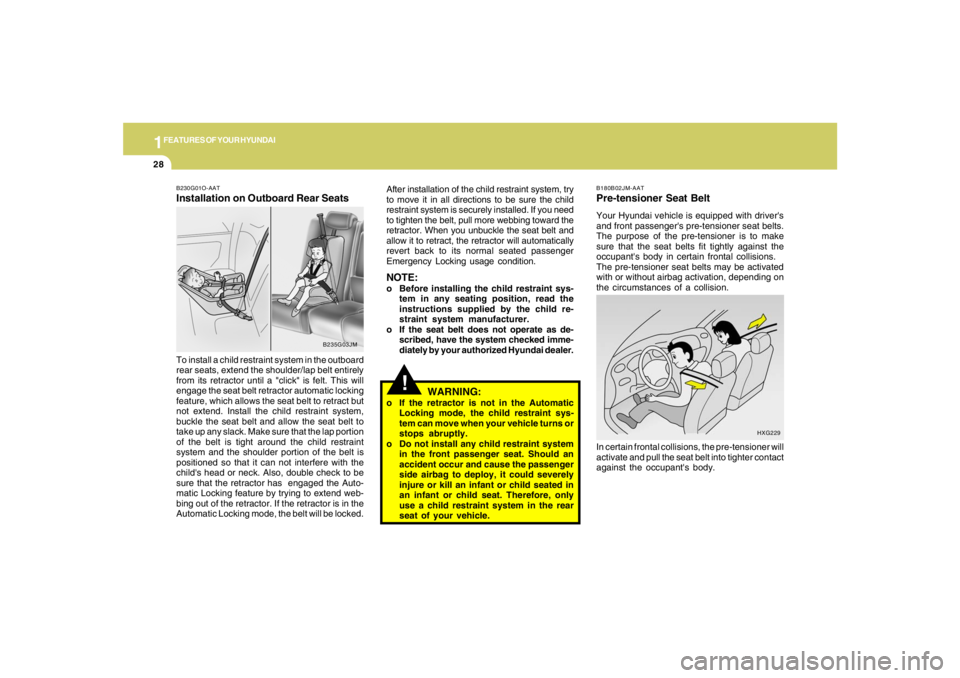
1FEATURES OF YOUR HYUNDAI28
HXG229
In certain frontal collisions, the pre-tensioner will
activate and pull the seat belt into tighter contact
against the occupant's body.B180B02JM-AATPre-tensioner Seat BeltYour Hyundai vehicle is equipped with driver's
and front passenger's pre-tensioner seat belts.
The purpose of the pre-tensioner is to make
sure that the seat belts fit tightly against the
occupant's body in certain frontal collisions.
The pre-tensioner seat belts may be activated
with or without airbag activation, depending on
the circumstances of a collision.
!
B230G01O-AATInstallation on Outboard Rear Seats
WARNING:
o If the retractor is not in the Automatic
Locking mode, the child restraint sys-
tem can move when your vehicle turns or
stops abruptly.
o Do not install any child restraint system
in the front passenger seat. Should an
accident occur and cause the passenger
side airbag to deploy, it could severely
injure or kill an infant or child seated in
an infant or child seat. Therefore, only
use a child restraint system in the rear
seat of your vehicle. To install a child restraint system in the outboard
rear seats, extend the shoulder/lap belt entirely
from its retractor until a "click" is felt. This will
engage the seat belt retractor automatic locking
feature, which allows the seat belt to retract but
not extend. Install the child restraint system,
buckle the seat belt and allow the seat belt to
take up any slack. Make sure that the lap portion
of the belt is tight around the child restraint
system and the shoulder portion of the belt is
positioned so that it can not interfere with the
child's head or neck. Also, double check to be
sure that the retractor has engaged the Auto-
matic Locking feature by trying to extend web-
bing out of the retractor. If the retractor is in the
Automatic Locking mode, the belt will be locked.After installation of the child restraint system, try
to move it in all directions to be sure the child
restraint system is securely installed. If you need
to tighten the belt, pull more webbing toward the
retractor. When you unbuckle the seat belt and
allow it to retract, the retractor will automatically
revert back to its normal seated passenger
Emergency Locking usage condition.NOTE:o Before installing the child restraint sys-
tem in any seating position, read the
instructions supplied by the child re-
straint system manufacturer.
o If the seat belt does not operate as de-
scribed, have the system checked imme-
diately by your authorized Hyundai dealer.
B235G03JM
Page 47 of 273
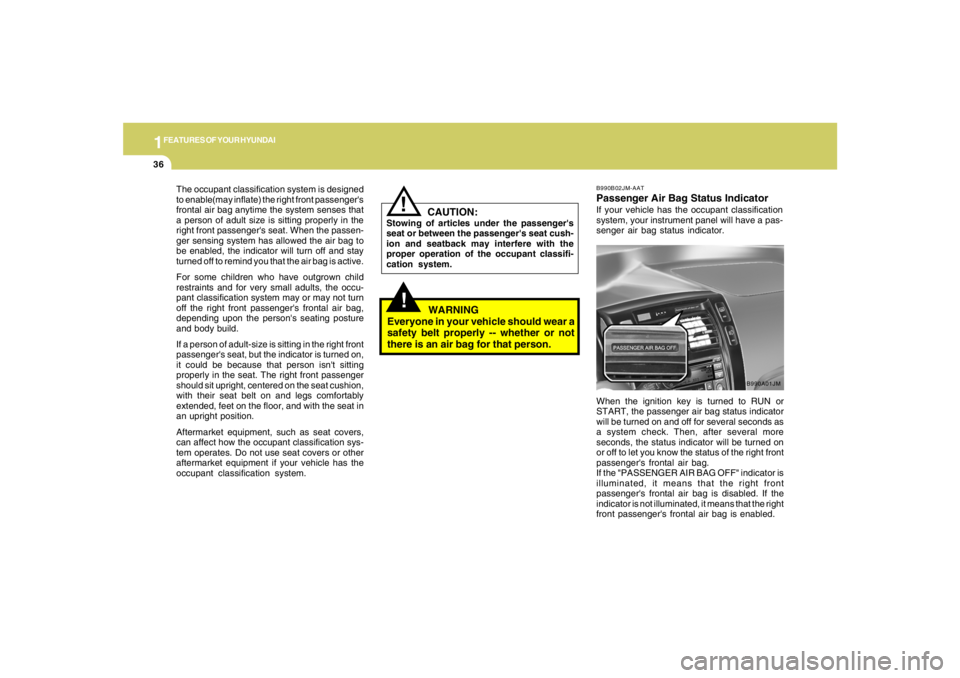
1FEATURES OF YOUR HYUNDAI36
!
The occupant classification system is designed
to enable(may inflate) the right front passenger's
frontal air bag anytime the system senses that
a person of adult size is sitting properly in the
right front passenger's seat. When the passen-
ger sensing system has allowed the air bag to
be enabled, the indicator will turn off and stay
turned off to remind you that the air bag is active.
For some children who have outgrown child
restraints and for very small adults, the occu-
pant classification system may or may not turn
off the right front passenger's frontal air bag,
depending upon the person's seating posture
and body build.
If a person of adult-size is sitting in the right front
passenger's seat, but the indicator is turned on,
it could be because that person isn't sitting
properly in the seat. The right front passenger
should sit upright, centered on the seat cushion,
with their seat belt on and legs comfortably
extended, feet on the floor, and with the seat in
an upright position.
Aftermarket equipment, such as seat covers,
can affect how the occupant classification sys-
tem operates. Do not use seat covers or other
aftermarket equipment if your vehicle has the
occupant classification system.
!
B990B02JM-AATPassenger Air Bag Status IndicatorIf your vehicle has the occupant classification
system, your instrument panel will have a pas-
senger air bag status indicator.
When the ignition key is turned to RUN or
START, the passenger air bag status indicator
will be turned on and off for several seconds as
a system check. Then, after several more
seconds, the status indicator will be turned on
or off to let you know the status of the right front
passenger's frontal air bag.
If the "PASSENGER AIR BAG OFF" indicator is
illuminated, it means that the right front
passenger's frontal air bag is disabled. If the
indicator is not illuminated, it means that the right
front passenger's frontal air bag is enabled.
B990A01JM
CAUTION:
Stowing of articles under the passenger's
seat or between the passenger's seat cush-
ion and seatback may interfere with the
proper operation of the occupant classifi-
cation system.
WARNING
Everyone in your vehicle should wear a
safety belt properly -- whether or not
there is an air bag for that person.
Page 51 of 273
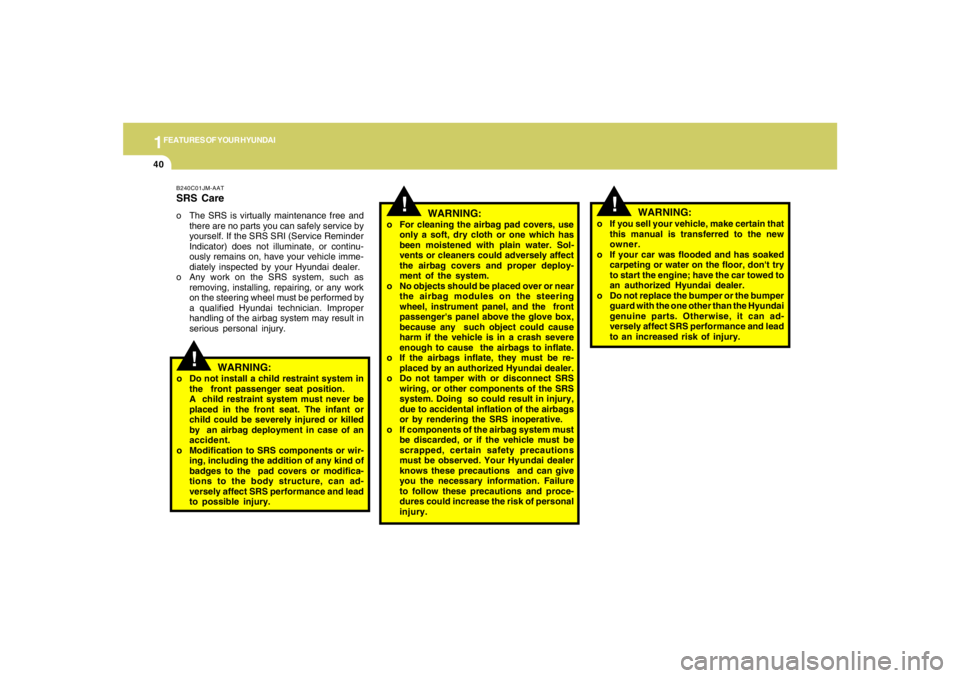
1FEATURES OF YOUR HYUNDAI40
!
o If you sell your vehicle, make certain that
this manual is transferred to the new
owner.
o If your car was flooded and has soaked
carpeting or water on the floor, don't try
to start the engine; have the car towed to
an authorized Hyundai dealer.
o Do not replace the bumper or the bumper
guard with the one other than the Hyundai
genuine parts. Otherwise, it can ad-
versely affect SRS performance and lead
to an increased risk of injury.
WARNING:
o For cleaning the airbag pad covers, use
only a soft, dry cloth or one which has
been moistened with plain water. Sol-
vents or cleaners could adversely affect
the airbag covers and proper deploy-
ment of the system.
o No objects should be placed over or near
the airbag modules on the steering
wheel, instrument panel, and the front
passenger's panel above the glove box,
because any such object could cause
harm if the vehicle is in a crash severe
enough to cause the airbags to inflate.
o If the airbags inflate, they must be re-
placed by an authorized Hyundai dealer.
o Do not tamper with or disconnect SRS
wiring, or other components of the SRS
system. Doing so could result in injury,
due to accidental inflation of the airbags
or by rendering the SRS inoperative.
o If components of the airbag system must
be discarded, or if the vehicle must be
scrapped, certain safety precautions
must be observed. Your Hyundai dealer
knows these precautions and can give
you the necessary information. Failure
to follow these precautions and proce-
dures could increase the risk of personal
injury.
!
WARNING:
!
WARNING:
o Do not install a child restraint system in
the front passenger seat position.
A child restraint system must never be
placed in the front seat. The infant or
child could be severely injured or killed
by an airbag deployment in case of an
accident.
o Modification to SRS components or wir-
ing, including the addition of any kind of
badges to the pad covers or modifica-
tions to the body structure, can ad-
versely affect SRS performance and lead
to possible injury.B240C01JM-AATSRS Careo The SRS is virtually maintenance free and
there are no parts you can safely service by
yourself. If the SRS SRI (Service Reminder
Indicator) does not illuminate, or continu-
ously remains on, have your vehicle imme-
diately inspected by your Hyundai dealer.
o Any work on the SRS system, such as
removing, installing, repairing, or any work
on the steering wheel must be performed by
a qualified Hyundai technician. Improper
handling of the airbag system may result in
serious personal injury.
Page 56 of 273
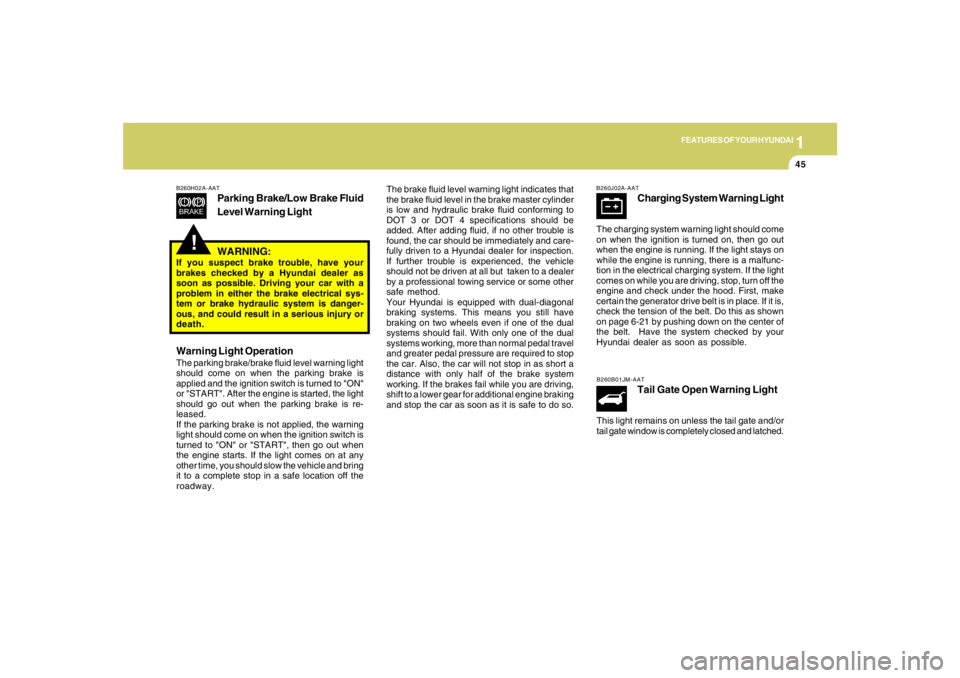
1
FEATURES OF YOUR HYUNDAI
45
!
B260H02A-AAT
Parking Brake/Low Brake Fluid
Level Warning Light
The brake fluid level warning light indicates that
the brake fluid level in the brake master cylinder
is low and hydraulic brake fluid conforming to
DOT 3 or DOT 4 specifications should be
added. After adding fluid, if no other trouble is
found, the car should be immediately and care-
fully driven to a Hyundai dealer for inspection.
If further trouble is experienced, the vehicle
should not be driven at all but taken to a dealer
by a professional towing service or some other
safe method.
Your Hyundai is equipped with dual-diagonal
braking systems. This means you still have
braking on two wheels even if one of the dual
systems should fail. With only one of the dual
systems working, more than normal pedal travel
and greater pedal pressure are required to stop
the car. Also, the car will not stop in as short a
distance with only half of the brake system
working. If the brakes fail while you are driving,
shift to a lower gear for additional engine braking
and stop the car as soon as it is safe to do so.
WARNING:
If you suspect brake trouble, have your
brakes checked by a Hyundai dealer as
soon as possible. Driving your car with a
problem in either the brake electrical sys-
tem or brake hydraulic system is danger-
ous, and could result in a serious injury or
death.Warning Light OperationThe parking brake/brake fluid level warning light
should come on when the parking brake is
applied and the ignition switch is turned to "ON"
or "START". After the engine is started, the light
should go out when the parking brake is re-
leased.
If the parking brake is not applied, the warning
light should come on when the ignition switch is
turned to "ON" or "START", then go out when
the engine starts. If the light comes on at any
other time, you should slow the vehicle and bring
it to a complete stop in a safe location off the
roadway.
B260J02A-AAT
Charging System Warning Light
The charging system warning light should come
on when the ignition is turned on, then go out
when the engine is running. If the light stays on
while the engine is running, there is a malfunc-
tion in the electrical charging system. If the light
comes on while you are driving, stop, turn off the
engine and check under the hood. First, make
certain the generator drive belt is in place. If it is,
check the tension of the belt. Do this as shown
on page 6-21 by pushing down on the center of
the belt. Have the system checked by your
Hyundai dealer as soon as possible.B260B01JM-AAT
Tail Gate Open Warning Light
This light remains on unless the tail gate and/or
tail gate window is completely closed and latched.
Page 64 of 273

1
FEATURES OF YOUR HYUNDAI
53
B340D01A-AATHigh-beam SwitchTo turn on the headlight high beams, push the
lever forward (away from you). The High Beam
Indicator Light will come on at the same time. For
low beams, pull the lever back toward you.B340E01A-AATHeadlight FlasherTo flash the headlights, pull the switch lever
toward you, then release it. The headlights can
be flashed even though the headlight switch is
in the "OFF" position.
B340B01A-AATLane Change SignalTo indicate a lane change, move the lever up or
down to a point where it begins flashing.
The lever will automatically return to the center
position when released.
B340C03A-AATHeadlight SwitchTo operate the headlights, turn the barrel on the
end of the multi-function switch. The first posi-
tion turns on the parking lights, sidelights, tail
lights and instrument panel lights. The second
position turns on the headlights.NOTE:The ignition must be in the "ON" position
to turn on the headlights.Parking Light Auto OffIf you do not turn the parking lights "OFF" after
driving, the parking lights will automatically shut
"OFF" when the driver's door is opened.
To turn them "ON" again, you must simply turn
the ignition key to the "ON" position.
HJM2089
HJM2084
HJM2088